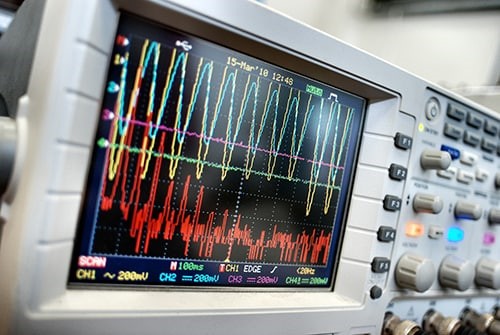By Rudy Ramos, Mouser Electronics
As we discussed in the earlier article on entry-level test benches, there are key pieces of equipment that every test bench should have regardless of level. What’s different about mid-level and top-end test benches is not so much the type of equipment but the performance levels required. It may also be that combination instruments suitable for one level may need dedicated devices at a higher level.
Any electronics test bench should include:
- Multimeters (sometimes called a volt-ohm-milliammeter, or VOM)
- Power supplies
- Soldering stations
- Oscilloscopes
- Accessories, including hand tools and supplies
If you’re an educator, electronics maintenance and repair professional, or a more advanced hobbyist or student, you’ll need a fairly sophisticated test bench. You’ll want multiple inputs and outputs, high-power/-wattage supplies, a range of measurement features, and gear that’s both easy to set up and use. The equipment also should be sufficiently robust so that it can cater to your more demanding measurement requirements. You may also need specially tailored test equipment for the technology you’re working on.
Here are recommendations for mid-level test bench equipment:
Mid-range multimeters
A mid-range bench multimeter will typically offer higher resolution and be able to display more digits than your basic unit. A handheld three-digit meter may be fine for basic hobby work, but the more serious test bench should have a bench unit sporting five or more digits. The multimeter should also be able to measure things like period, frequency, statistics, and histograms. Remember, too, to calibrate your mid-range multimeter at least once a year to maintain its accuracy.
A good product in this range is Fluke’s Bench Digital Multimeter NIST W/Data.
Mid-range power supplies
Think about the kinds of tests you’ll be performing as you choose your power supply. Will you need constant voltage and current, variable voltage and current, or both? Do you need to be able to set your power supply’s output manually? Do you require a low-noise linear power supply for things like control circuit testing, data acquisition, and signal processing? Do you need an uninterruptible power supply (UPS)? Do you need two discrete power supplies so that you can run both high-current/high-voltage and low-current/low-voltage tests?
If you want a mid-range power supply, have a look at the 1350 Triple Output Program DC Supply from Global Specialties.
Mid-range soldering stations
Basic soldering stations typically have a stand, power supply, pencil iron, and sponge. Mid-range soldering stations typically deliver better performance and are more efficient than their entry-level counterparts and may offer features such as temperature control and configurable pencils. Additional features may include a graphic display, fume extractor, heating plates, solder pencil recognition, automatic standby, and even the possibility to upgrade the station’s firmware. Have a look at the Apex Tool Group’s Weller WT1 and WT1H soldering stations if you’re after something mid-range.
Mid-range oscilloscopes
Mid-range oscilloscopes differ most from basic models in their bandwidth and rise time (edge speeds). A basic oscilloscope will typically offer no more than 100-MHz bandwidth, whereas a mid-range product will go up to 500 MHz. The increased rise-time capability helps you more accurately measure pulses and steps in things like timing signals.
Both the Teledyne LeCroy WaveSurfer 3000 Oscilloscopes and Tektronix MDO3000 Mixed Domain Oscilloscope are excellent examples of oscilloscopes in the mid-range.
Mid-range accessories
To complement the equipment above, think about adding some accessories to your test bench. Consider an extractor for solder fumes, which uses activated carbon filtration or a HEPA filter. Ring magnifier lamps are also extremely useful, making small components easier to see and solder, reducing eye fatigue. A vise is another highly recommended accessory to have. It allows you to hold things in place while you work on them, thereby freeing your hands.
The Soldering Fume Abs ESD from Jonard Industries, Luxo Corporation’s LED Magnifier Lamp, and the PCB Holder, Multi-purpose vise from PanaVise are three ideal additions to your mid-range test bench.
The top-end electronics test bench

Delve deep into the design of your circuits and analyze elusive electrical signals with a high-end oscilloscope.
For those working at the top end of electronics design, such as certified electronics professionals or anyone needing to guarantee their repair work or needing to comply with standards, a top-end test bench is a must-have. While this level of test bench still needs the same basic functionality as the others, much of that equipment will be specialized and will need frequent calibration.
For instance, unlike mid-range equipment, which typically packs in lots of features, top-end test bench equipment usually has fewer features in each piece. Instead, the equipment offers the highest levels of precision and is targeted at specific use cases.
Examples of test equipment in this range include the Keithley Model DMM7510 Graphical Sampling Multimeter, Keithley 2260B Programmable DC Power Supplies, Tektronix TSG4100A RF Vector Signal Generators, Teledyne LeCroy HDO 4000 Series High-Definition Oscilloscopes, and Apex Tool Group Soldering Workstation.
In summary
Regardless of whether you’re an electronics enthusiast just starting to tinker with circuit design or a professional engineer creating the circuits for state-of-the-art applications, your testing will deliver the best results (and experiences) if the equipment you’re using is aligned with your needs.
Every test bench should include a multimeter, power supply, soldering station, accessories, and possibly an oscilloscope. Entry-level equipment is the most affordable but is typically less capable and offers fewer features than mid-range versions. And at the top end of the spectrum is electronics test equipment that tends to have fewer features but is highly specialized and precise.
To make the best choices, think about what you need the test equipment for, what your budget is, and how your requirements may change over time. Then get to work assembling your perfect test bench.
Advertisement
Learn more about Mouser Electronics





